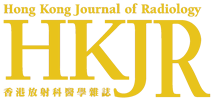KH Yu, M Chua, AC Vlantis, MKM Kam, WY Lee, RKY Tsang, HY Yuen, EP Hui, ATC Chan
Hong Kong J Radiol 2005;8:207-13
Objective: To investigate swallowing function outcome in patients with head and neck cancer who received altered fractionation radiotherapy.
Patients and Methods: Forty nine patients with bulky T2 tumours or American Joint Committee on Cancer stage III/IV disease were treated with
